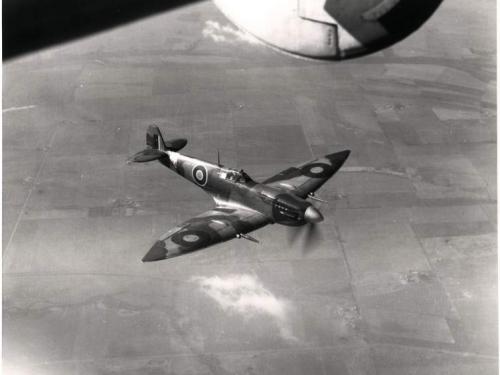
Stories of daring, stories of technological feats, stories of prevailing against the odds ... these are the stories we tell at the National Air and Space Museum. Dive in to the stories below to discover, learn, and be inspired.
Showing 81 - 90 of 158

July 21, 2017
Christopher Nolan’s latest movie, Dunkirk, brought the battle into theaters. And although you may know it stars actors such as Tom Hardy, Harry Styles, and Cillian Murphy, you may not know that the National Air and Space Museum houses examples of two of the main airplanes featured in the film. We have a Royal Air Force (RAF) Supermarine Spitfire and a Messerschmitt Bf 109 of the Luftwaffe, although the Museum’s aircraft are slightly younger than those that participated in Operation Dynamo.

June 15, 2017
Although less well known than Wings, The Dawn Patrol, and Hell’s Angels, The Eagle and the Hawk was one of the best World War I dramas of the 1930s. Based on an original story by John Monk Saunders, who also wrote the original story for Wings, The Eagle and the Hawk focuses on the psychological aspects of wartime aerial combat. It explores the cumulative effects on pilots and crews who fought in the skies during World War I, rather than on the romanticized heroic exploits of fighter pilots.

May 23, 2017
All Quiet on the Western Front, based on the 1929 novel of the same name by Erich Maria Remarque, is still considered one of the best films ever made in the war movie genre. Released in 1930, All Quiet on the Western Front was a reflection of the profound disillusionment with war in the post-World War I (WWI) era. It was the first significant anti-war movie, exploring the war’s physical and psychological impact on a generation lost to war.

April 13, 2017
After Germany invaded Belgium in August 1914, a British blockade to prevent supplies reaching Germany also isolated the Belgian people. The Commission for Belgian Relief (CRB), chaired by future U.S. president Herbert Hoover, negotiated delivery of food and goods to civilians living there. Among the items was thread to Belgian lace makers. The CRB managed sales and deliveries of Belgian war lace to people in the Allied countries wishing to support the Belgian population.

April 13, 2017
With male family members at the battlefront, wounded, or killed, French peasant women used their needlework skills to maintain their livelihoods and rebuild their war-torn communities. Thousands of American women volunteers in France, especially those associated with the American Committee for a Devastated France, sponsored them.

April 12, 2017
The signature aspect of the First World War in Europe was the protracted stalemate of trench warfare. After a brief period of mobility over the battlefield in the first months of the conflict, the opposing armies settled into a long and deadly war of attrition.

April 06, 2017
World War I, also known as the Great War, engaged all the great powers of Europe, and their worldwide colonial empires, including South Africa, German East Africa, French West Africa, Morocco, Algeria, Egypt, India, Vietnam, Australia, New Zealand, the West Indies, and Canada. The United States, Japan, and China also entered the conflict. More than 70 million military personnel were mobilized by all nations. The modern industrial capacity of the principal combatant countries fueled one of history’s most destructive wars.

April 06, 2017
Although the assignment of the eight AEF artists to the U.S. Army Corps of Engineers was purely a formality, they found the many and varied activities of this branch of the AEF interesting subject matter. The industrial scale of the military effort demanded an enormous technical and logistical presence. Tens of thousands of men served loading, unloading, stockpiling, moving, and maintaining the tons of war materiel sent to France in support of the combat troops.

April 06, 2017
The AEF artists were embedded with the troops to capture the full experience of those serving in Europe, not only what transpired on the battlefield. Beyond combat scenes and the ravages of war, their work also depicted mundane everyday chores, feeding the troops, personal time, and entertainment—subjects very different from traditional war art that focused on heroic figures and gallantry on the field of battle. These works contributed to a more complete and realistic view of the war experience.

April 06, 2017
The AEF artists had great freedom to travel about, affording them broad access to events, including combat. Although devoid of the more shocking realities of war that photography captured, their depictions of the battlefield powerfully convey a sense of immediacy and on-the-spot observation. Their art provides a window on their role as both recorders of history and as first-hand participants in that history. Most of the AEF artists were trained and worked as professional illustrators before the war. Their approach placed the viewer on the scene in ways not common in earlier war art.